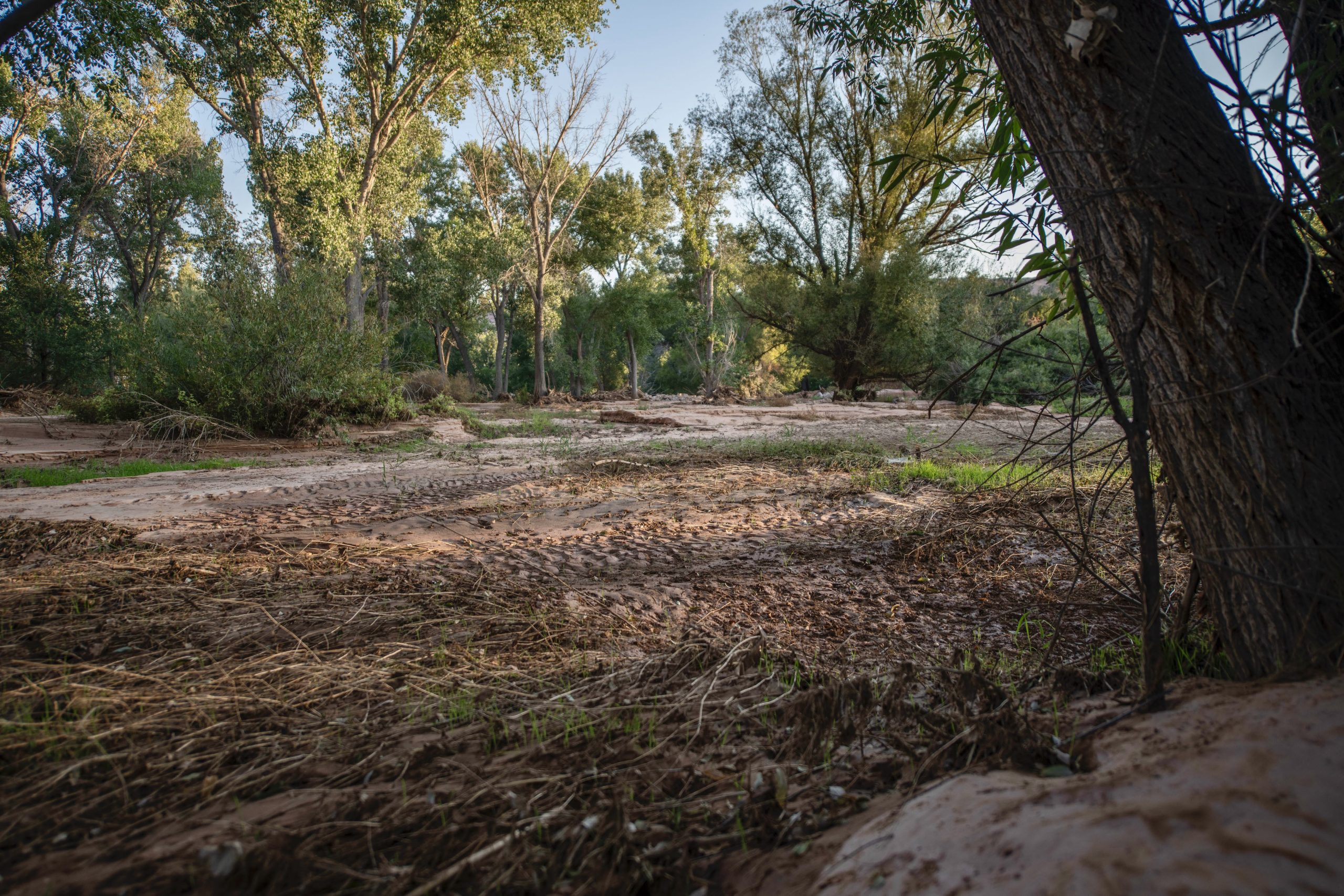Some information may be outdated.
When Mill Creek flooded on Aug. 20, 2022, the record-setting floodwaters swept through town, spreading debris and damaging infrastructure. But the flood also allowed Kara Dohrenwend, director of the environmental nonprofit Rim to Rim Restoration, to test how restoration areas held up.
Over the last 20 years or so, RRR has removed invasive species such as tamarisk and Russian olive from areas around Moab—the invasives are crowding out native plants, especially near the Mill and Pack creeks. Originally, Dohrenwend said the nonprofit removed invasive plants because of creek health and fire fuel potential—invasive plants make a “wick through the whole town,” she said. But now, she’s seeing another reason: areas that had invasive plants removed fared better during the flood, damage-wise, than those that didn’t. By removing the invasives, the creeks could function as they were supposed to, Dohrenwend said—flashflood and all.
“This flood, for me, has been fascinating,” she said. “What I’m seeing is that the places where we got the olive out, the water could do what it needed to do: it spread out, which allowed it to slow down.”
Dohrenwend pointed out a specific area near 100 S. and Bullick Cross Creek Park, where floodwaters damaged a city waterline. The area is still choked by Russian olive in some places, but in the space where RRR managed to take some of the olive out, floodwaters spread hundreds of feet, leaving behind sand and mud. But that’s a sign of a healthy and normal system for Moab, Dohrenwend said.
“We live in a flashy system. The way it looks now, after the flood, is more similar to what it looked like before [the invasives],” Dohrenwend said. “Sometimes you have to remove something from the system to restore the system.”
Plus, through the sand and mud left behind, a few natives, such as dogbane, are already starting to bounce back, and Dohrenwend has no worries that perennials will be able to return.
“In the places where the removal happened, there’s not as much debris that got caught up—it was able to move,” Dohrenwend said. “In the places where there were obstacles, the more the water got dammed up, it channelized, and it moved faster.”

For now, the first step, Dohrenwend said, is to clean up the debris and restore the flood plain—RRR is working with the City of Moab and the State of Utah to find funds for debris removal projects. The next step is to start identifying areas that RRR specifically can help: Dohrenwend is looking into if there’s any private property, or property the city doesn’t control, that may become a risk.
“If we were to get another flood next week, there’s still a lot of debris along the Mill Creek pathway—if it was gone, life would be better,” she said. “And coupled with that is all those debris piles, when there’s cheatgrass and other fine fuels in here next year, those debris piles become fire danger.”
RRR is also looking into re-seeding flood areas, although not right away, Dohrenwend said. She’ll allow native plants to come back first, and then she’ll look into replanting with other native grasses and wildflowers.
“By spring, and when we talk to the state about this, we’ll find locations where willows could hold up the banks—their roots are the most amazing stabilizer,” she said.
Once the next few months of debris removal and replanting are finished, Dohrenwend will look even further into the future of how to prevent flood damage in the first place. The RRR office was damaged during the Aug. 20 flood, but Dohrenwend said the nonprofit has plans to move into the old Utah State University campus, which is now owned by the Moab Free Health Clinic. The office damage made her think about how the city is being built, she said: “The reason we got hit—and other businesses on the street got hit too, but we got decimated—is because we were the lowest one,” she said.
As Dohrenwend looked out over the flood-damaged area near Bullick Cross Creek Park, her mind flooded with ideas as to how to prepare for another flood—“We’ll figure out, where are those high flow channels? How do we make sure they stay clear? And even if you end up with a native shrub in there, maybe that gets removed—we’ll make sure we have grasses and coyote willow that can lay down in a flood.”
“A lot of what we try to do [at RRR] is work across political boundaries,” Dohrenwend said. “We can work with private landowners, we can work with the city, we can work with the state, we can work with the Bureau of Land Management, because this—the flood—doesn’t care. You can’t ad-hoc manage it … You have to really embrace the fact that we live in a flashy system.”
Appreciate the coverage? Help keep local news alive.
Chip in to support the Moab Sun News.





